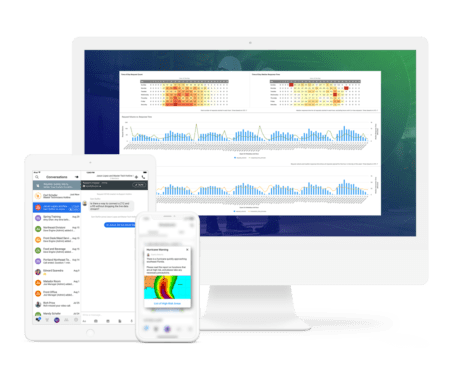When Deskless Workers Get The Technology They Need, Everyone Wins
From Google to Slack, advancements in technology have given desk workers new ways to communicate, collaborate, and ultimately become more productive — and this trend isn’t slowing down. But going underserved for far too long has been the vast majority of U.S. workers, that is, deskless workers. Companies provide countless apps for desk workers to use but fall short when it comes to deploying apps purpose-built for deskless workers.
Deskless workers comprise anywhere from 72-80 percent of the entire workforce. They include field service technicians, hotel staff, utility workers, flight crews, warehouse staff, manufacturing plant engineers — the list goes on. United by the fact that they don’t complete their work from a desktop computer, apps that help them communicate and collaborate every day is something that’s been historically unavailable to them.
But now with everyone using a smartphone or mobile device, there is a huge opportunity for technology to seamlessly connect these workers with each other and the larger organization.
Deskless Workers Need Applications As Much As Anyone Else, If Not More
When field service and other frontline workers are out on the job, they need information at their fingertips. Whether they are installing machinery or responding to a hotel guest request, access to knowledgeable teammates and company information can make or break their success. They can’t simply walk down the hall to ask a question and therefore desperately need technology that lets them easily communicate and find the information they need in real time, right from their mobile device.
There are multiple ways that empowering remote workers with easy-to-use apps benefits the business. Most importantly, deploying tech solutions that are built for deskless workers creates workers that are constantly in-the-know, connected to the company and more productive overall.
1. Always In-the-Know
With real-time communication available anytime, anywhere, frontline workers are always equipped with the information they need. Whether it’s referencing a service manual to know what screw to use, calling a support tech for help, or messaging the scheduling center to report a job’s completion, communication is a crucial part of the deskless worker’s day.
Facilitating team communication among and between deskless workers as well as their desk-based counterparts through messaging, calling, video calling, push to talk and file sharing means they can instantly resolve issues as they arise. When all teams and departments are connected and discoverable on a single company communication app, problems that once took 3 days to solve can now be resolved in a matter of minutes.
2. Connected to the Company
A major stumbling block for companies that have dispersed workforces is that they often fail to include them in corporate communications. Email is the default method for desk workers, and when corporate sends updates, they often go through this channel as well as a company Intranet or even bulletin board. This is a problem because deskless workers simply don’t use those methods. And the result is that many deskless and remote workers feel shunned and left out, leading to high turnover rates these industries.
By giving desk workers a way to Broadcast important updates and safety alerts straight to the app deskless workers use to communicate, corporate functions ensure their updates are received and read. This integration of corporate communications into the platform that frontline workers use every day means they are always connected to what’s happening at the company. For employees that are inherently siloed from each other and the business, this is a big deal.
3. More Productive
Companies are always looking for ways to boost productivity. In deskless industries with a large number of field service employees, productivity is measured to the second. And while communication may not be the first thing you think of when looking for ways to boost productivity, it’s actually a goldmine, for a few reasons.
First, it reduces the amount of time it takes to complete tasks. There’s no need to sit and wait for a response, rustle through documents to find the right answer, or get transferred again and again until you reach the person who has the information you need. With real-time mobile communication employees get answers fast.
Second, connecting deskless workers with their coworkers and the larger organization leads to higher satisfaction and engagement. This connectivity means employees feel like they are a part of something and have a voice. When they have successes they can use group messaging to celebrate together. When they have questions or concerns, they can reach out to the right department, even if they’ve never physically met the people there. Closing this communication gap and purposely communicating and listening to deskless teams leads to happier, more engaged employees who as it turns out, are the most productive employees.
Apps Built for Deskless Workers Are Finally In The Spotlight
While Zinc has been pioneering deskless communication for a few years now, apps built for deskless workers are starting to take off. Reporters and analysts are writing more and more about deskless and field service workers and new apps are popping up to capitalize on this market.
But the reality is that most companies have yet to start empowering their employees with communication technology that is built for deskless workers. Right now hundreds of thousands of deskless workers are solving their communication needs on their own, turning to consumer apps to stay informed while on the job. Not only is this unsafe for the business, but it also restricts the amount of knowledge employees can access while on the job to the dozen or so coworkers they know.
That’s why we are working to educate companies about the importance of communication for deskless workers and the difference an app built for deskless workers makes.
When it comes to this segment of the workforce, we believe that they should have the flexibility to choose the exact mode of communication that works best for any given situation. And just as important, do it in a way that is familiar and easy to use. Most enterprise solutions are clunky and confusing, leading to zero adoption across deskless workforces.
With Zinc Real-Time Communication, workers get a sleek user experience, access to real-time communication using every mode, and the seamless connection to their coworkers and company that they’ve never had before.

Zinc Real-Time Communication


Share this: